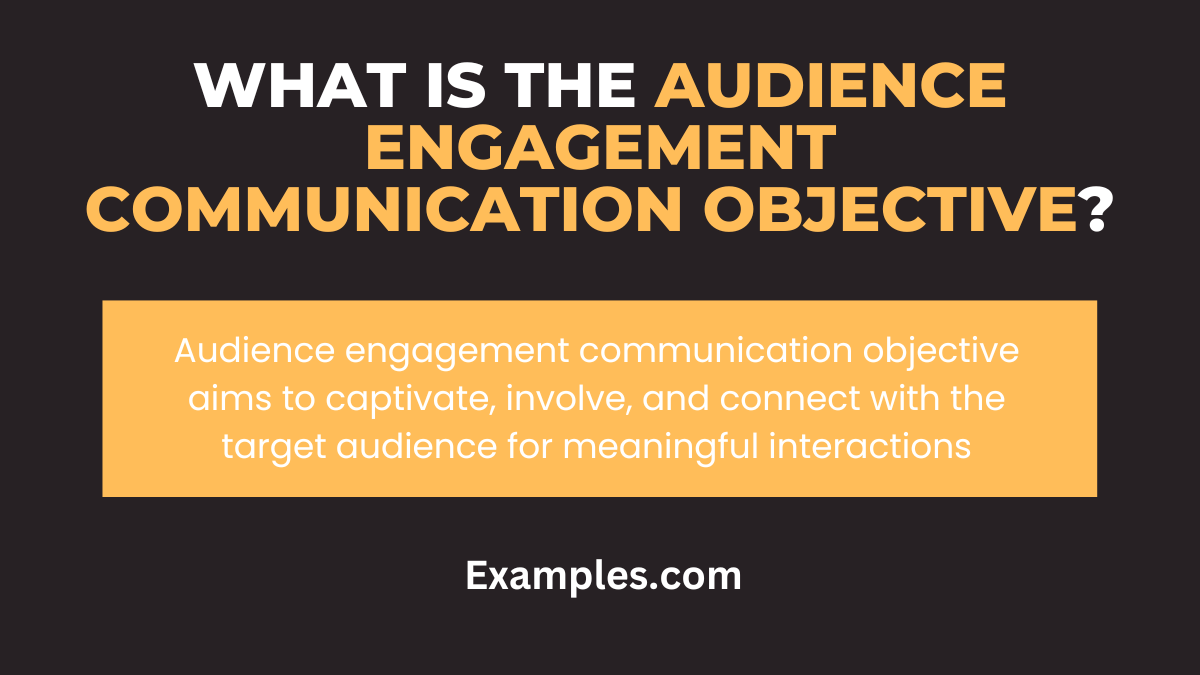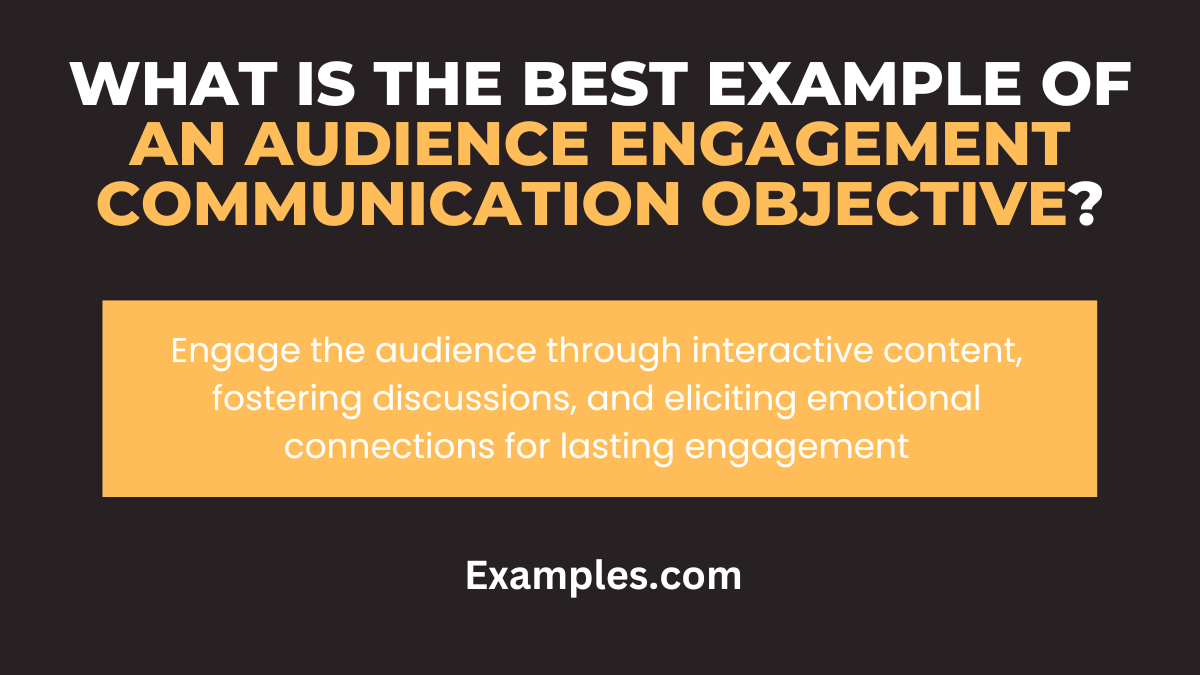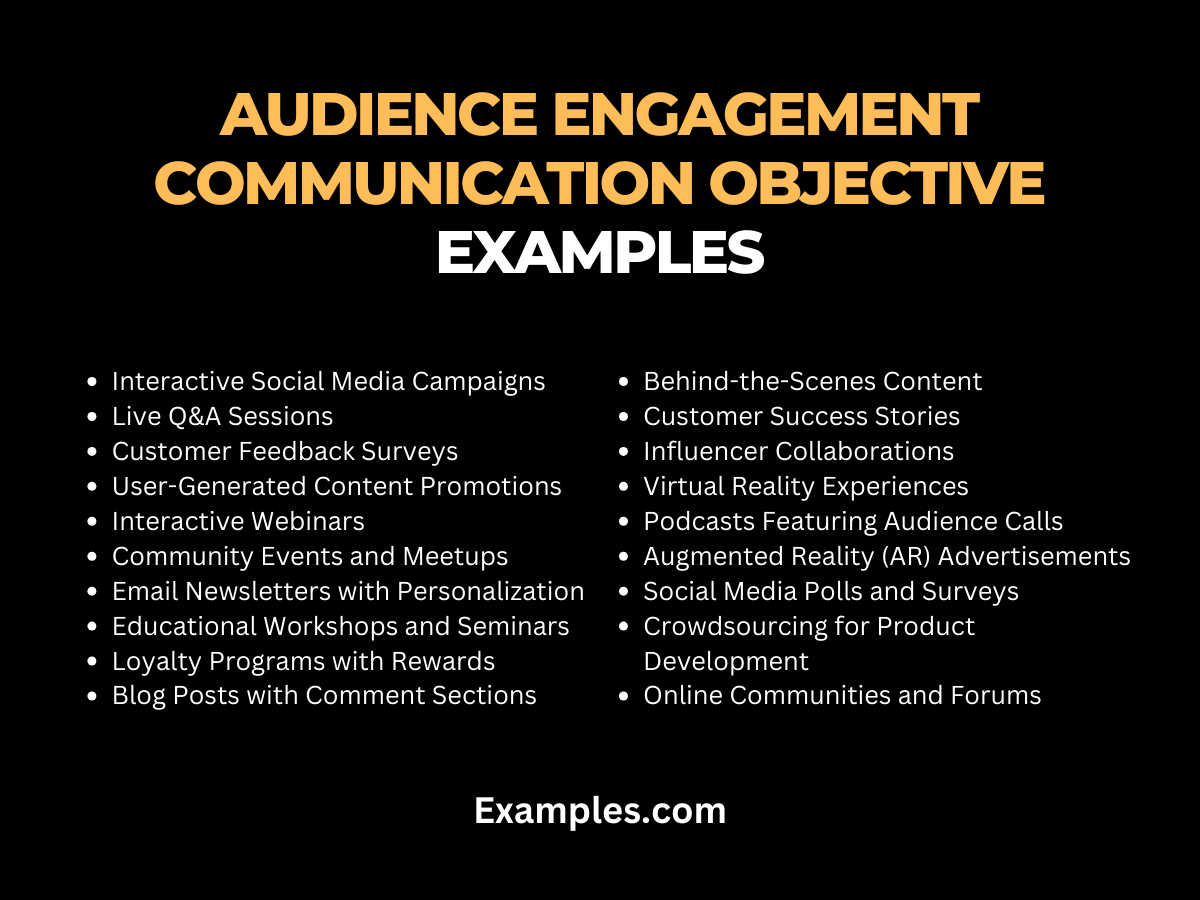Audience Engagement Communication Objective
The Audience Engagement Communication Objective focuses on creating a strong connection with your audience through interactive and meaningful communication. This objective is crucial in various fields such as marketing, education, public relations, and more. By prioritizing Communication Objectives that engage the audience, you can foster a deeper understanding, encourage active participation, and build a loyal community. Effective audience engagement involves not just sharing information but also listening, responding, and adapting to audience feedback.
What is the Audience Engagement Communication Objective?

An Audience Engagement Communication Objective aims to actively involve the audience in the communication process, creating a two-way interaction. It goes beyond simply delivering a message to encouraging audience participation, feedback, and interaction. This objective is essential for making the audience feel heard and valued, which in turn fosters a stronger relationship and deeper investment in the message or brand.
What is the Best Example of an Audience Engagement Communication Objective?

A prime example of an Audience Engagement Communication Objective is a social media campaign where a brand encourages its followers to share their experiences or ideas related to its products. The campaign might include interactive polls, user-generated content, and prompt responses to comments and messages, creating a dynamic and engaging online community. This approach not only spreads the brand’s message but also builds a loyal and active audience base.
20 Audience Engagement Communication Objective Examples

- Interactive Social Media Campaigns: Encouraging followers to participate in online contests.
Example: “Join our hashtag challenge and get a chance to be featured!” - Live Q&A Sessions: Hosting live sessions to answer audience questions.
Example: “Tune in for our live Q&A and ask your burning questions.” - Customer Feedback Surveys: Collecting and acting on customer feedback.
Example: “Tell us what you think and help us improve!” - User-Generated Content Promotions: Inviting customers to share their experiences.
Example: “Share your story with our product and be part of our community.” - Interactive Webinars: Conducting webinars with audience participation.
Example: “Join our webinar and participate in the interactive poll.” - Community Events and Meetups: Organizing events for direct audience interaction.
Example: “Meet us at the community event this weekend!” - Email Newsletters with Personalization: Sending tailored content to subscribers.
Example: “Check out our latest tailored recommendations just for you.” - Educational Workshops and Seminars: Providing valuable information in an engaging way.
Example: “Enhance your skills with our interactive workshops.” - Loyalty Programs with Rewards: Encouraging continued engagement through rewards.
Example: “Earn points with every purchase and redeem exciting rewards.” - Blog Posts with Comment Sections: Inviting readers to share their thoughts.
Example: “Let us know your thoughts in the comments below.” - Behind-the-Scenes Content: Sharing insider views of the company or product.
Example: “Take a sneak peek behind the scenes of our latest project.” - Customer Success Stories: Highlighting and sharing customer experiences.
Example: “Read about how our product changed lives.” - Influencer Collaborations: Partnering with influencers for wider reach.
Example: “Check out our collaboration with famous influencers.” - Virtual Reality Experiences: Offering immersive experiences through VR.
Example: “Experience our product like never before with our VR tour.” - Podcasts Featuring Audience Calls: Incorporating listener calls into podcasts.
Example: “Call in to share your thoughts on our next podcast.” - Augmented Reality (AR) Advertisements: Engaging customers through AR technology.
Example: “Discover our products in AR and see them come to life.” - Social Media Polls and Surveys: Gaining insights through interactive polls.
Example: “Vote in our poll and let us know your preference.” - Crowdsourcing for Product Development: Involving the audience in creating new products.
Example: “Help us decide on our next product feature!” - Online Communities and Forums: Building platforms for discussion and interaction.
Example: “Join our online forum and connect with fellow enthusiasts.” - Mobile App Engagement Features: Encouraging interaction through app features.
Example: “Use our app’s interactive features for a unique experience.”
These examples demonstrate various ways to engage with audiences effectively, emphasizing the importance of active and creative communication strategies in building and maintaining audience interest and involvement.
Relationship Building Communication Objective in Business
In business, Relationship Building Communication Objectives are key to establishing and nurturing connections that contribute to long-term success.
- Developing Trust with Clients: Building a foundation of trust through transparent communication.
- Enhancing Supplier Relations: Maintaining regular, open dialogue with suppliers.
- Strengthening Investor Confidence: Providing consistent, honest updates to investors.
- Collaborating with Business Partners: Fostering cooperative relationships for mutual benefit.
- Improving Customer Retention: Keeping customers engaged with regular communication.
- Networking for Growth: Expanding business opportunities through networking.
- Building Brand Loyalty: Creating a strong emotional connection with the brand.
- Facilitating Strategic Alliances: Leveraging communication for beneficial partnerships.
- Resolving Conflicts: Addressing disputes effectively through dialogue.
- Cultivating Community Involvement: Engaging with the local community to enhance brand reputation.
Achieving these objectives strengthens business relationships and drives growth.
Relationship Building Communication Objective in Marketing
Relationship Building Communication Objectives in marketing focus on creating a connection with the audience that extends beyond transactions.
- Creating Engaging Content: Producing content that resonates with the target audience.
- Utilizing Social Media Effectively: Engaging customers on social platforms.
- Personalizing Customer Interactions: Tailoring communication to individual customer needs.
- Conducting Customer Feedback Surveys: Actively seeking and responding to customer feedback.
- Implementing Customer Loyalty Programs: Encouraging repeat business and loyalty.
- Hosting Events and Webinars: Providing interactive platforms for engagement.
- Influencer Collaborations: Partnering with influencers to reach new audiences.
- Email Marketing with a Personal Touch: Sending personalized emails to connect with customers.
- Customer Service Excellence: Ensuring top-notch customer service.
- Community-Based Marketing Initiatives: Engaging in marketing that benefits the community.
These strategies build lasting relationships that boost marketing effectiveness.
Relationship Building Communication Objective in Workplace
In the workplace, Relationship Building Communication Objectives are essential for a harmonious and productive environment.
- Promoting Team Collaboration: Encouraging open communication among team members.
- Leadership Transparency: Leaders communicating openly with employees.
- Employee Recognition Programs: Acknowledging and appreciating employee contributions.
- Regular Team Meetings: Facilitating communication and team bonding.
- Conflict Resolution Initiatives: Addressing and resolving workplace conflicts.
- Professional Development Opportunities: Encouraging growth and learning.
- Diversity and Inclusion Efforts: Promoting understanding and respect.
- Work-Life Balance Support: Recognizing and supporting employee needs.
- Feedback Culture: Encouraging and valuing feedback from all levels.
- Internal Networking Events: Providing opportunities for internal networking.
These objectives foster a supportive and engaged workplace culture.
Goals of Relationship Building Communication Objective
The Goals of Relationship Building Communication Objectives are to establish and maintain positive and productive relationships.
- Enhancing Understanding and Empathy: Promoting mutual understanding among individuals.
- Building Trust: Creating a foundation of trust through communication.
- Encouraging Cooperation: Fostering a spirit of collaboration and teamwork.
- Improving Conflict Resolution: Enhancing the ability to resolve disputes amicably.
- Strengthening Team Dynamics: Creating stronger bonds within teams.
- Increasing Engagement: Boosting involvement and interest in tasks or initiatives.
- Facilitating Change Management: Easing the adoption of new changes or policies.
- Promoting Loyalty and Commitment: Encouraging dedication to the organization or cause.
Achieving these goals leads to more successful and satisfying relationships.
Importance of Relationship Building Communication Objective
Understanding the Importance of Relationship Building Communication Objectives is crucial for any organization or individual.
- Improves Team Performance: Strong relationships enhance teamwork and productivity.
- Boosts Employee Morale: Positive relationships increase job satisfaction.
- Enhances Customer Retention: Good relationships keep customers coming back.
- Facilitates Effective Problem Solving: Better relationships lead to more effective resolution of issues.
- Drives Business Growth: Strong relationships can lead to new opportunities.
- Supports a Positive Workplace Culture: Good communication fosters a healthy work environment.
- Encourages Innovation: Open communication can spark creativity and new ideas.
- Builds a Strong Brand Image: Positive relationships enhance the brand’s reputation.
In summary, relationship-building communication objectives are vital for fostering positive and productive interactions in various contexts.
The Audience Engagement Communication Objective is vital for creating meaningful and interactive relationships with your audience. Whether in business, marketing, or other fields, engaging effectively with your audience can lead to deeper connections, increased loyalty, and more impactful communication. This guide provides essential strategies and insights for achieving successful audience engagement, emphasizing the importance of active participation, feedback, and personalized communication in building lasting relationships with your audience.



